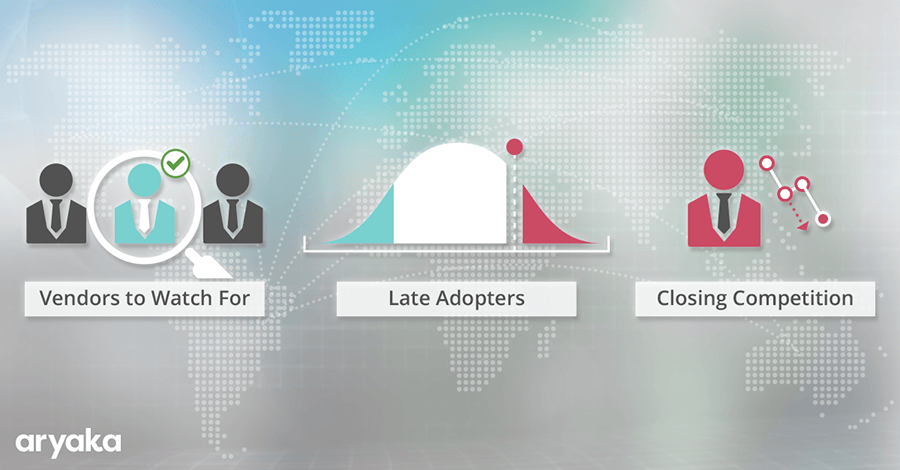SD-WAN Market: Winners and Losers

SD-WAN is growing fast, delivering quantifiable benefits to enterprises and reshaping technology markets. The stakes are high and the playing field is shifting, so the question is, which suppliers will be left standing when the dust settles?
It is a complex query because players from so many sectors are involved and the enterprise consumption models vary. But by this point there is little question about the promise of the technology and the promise for disruption.
Enterprises are faced with exploding bandwidth demands and expensive, static MPLS WAN backbones. They need a way to cost effectively add capacity in a timely fashion, while also making the network application-aware so it can adapt to shifting needs. SD-WAN has delivered, and the market is taking off. IDC says SD-WAN sales are growing at a 69% compound annual growth rate and will hit $2.3 billion this year and $8 billion in 2021.
Multiple Sectors
The growth to date has been driven by standalone SD-WAN players, but their rapid ascent has caught the attention of entrenched vendors who are, 1) attracted by the market potential, and 2) fearful of being disrupted by it. That has, in turn, driven multiple acquisitions. Cisco, for example, acquired Viptela in August 2017 for $610 million, and VMware acquired VeloCloud in December of that year to get WAN technology to complement its NSX virtual network product.
Other infrastructure players, such as Juniper and Citrix, already have some of the SD-WAN pieces but haven’t made a ripple in terms of market share, so it will be interesting to see if they continue to try to go it alone or look to buy some of the remaining standalone SD-WAN players. Still others, such as Arista, have yet to play a card, and it is unclear if they will or not.
Given the potential for SD-WAN to converge functions ranging from load balancing to security, analysts point out that suppliers in adjacent market sectors may feel like they have skin in the game. For example, since SD-WAN can deliver load balancing functions, will companies such as F5 feel the need to develop its own SD-WAN technology, or acquire or partner for the capabilities to safeguard against losing business to SD-WAN players?
And the same thing holds true on the security front. Security suppliers may fear losing branch office business to SD-WAN players that deliver integrated or best of breed solutions and feel the need to fight back, or at least partner. Some standalone SD-WAN players have already built their own security stacks while others have teamed with market leader security vendors.
And how about the incumbent telcos? Some have rolled out SD-WAN but is there a conflict of interest with MPLS? They have been slow to roll it out because MPLS is a roughly $20 billion business and cannibalizing that would result in a rapid decline in revenue.
Picking the Winners
What will distinguish the winners that emerge in this increasingly complicated SD-WAN market? A handful of factors. You need to consider:
- What is being virtualized? The majority of the SD-WAN players virtualize the network edge using appliances (physical or virtual), providing a way to augment MPLS using public Internet links. The appliance in a branch office determines whether traffic should be sent over MPLS or the Internet based on the needs of the application, the health of the link and pre-determined policies. But the Internet is the Internet. Network congestion, latency, packet loss and jitter take their toll, sapping response times and ruining user experiences, especially over longer links.The other approach is to virtualize the long-haul backbone, to replace the public, best effort Internet with a managed private network that is optimized, accelerated and secured. User traffic is pumped into regional points of presence and groomed for delivery over dedicated pipes to anywhere in the world, to other corporate locations or Software-as-a-Service cloud partners. Response times are fast and, just as important, consistent, worldwide. Critical business applications require nothing less.
- Delivered as a service or DIY? Most SD-WAN vendors are selling SD-WAN kits that require the enterprise to buy, build, deploy and manage components that, together, provide SD-WAN. If cloud adoption has taught us anything, it is that the Do It Yourself days are numbered. There are too few hours in the day, too few experts at the ready, too few capital dollars to tie up in still-evolving technology, to take this approach. The construction model is rapidly giving way to a consumption model. Buying SD-WAN as a service, delivered by providers that do nothing but SD-WAN, is the future. Deployment is in hours days, not weeks or months. Changes are achieved on the fly, anywhere in the world.
- Core focus or a feature? The SD-WAN market is still evolving, as evident with those recent acquisitions, and more consolidation is likely in the offing. The question is, what happens to the acquired technology? Does it get enough funding to continue to advance, or is it simply watered down and baked in as an upsell feature in a more expensive product? When customers buy product vs. service, they have to get involved in the messy details of product roadmaps (and if the technology was acquired, not just the roadmap for the SD-WAN product, but surrounding products that may absorb that function) and the stability and potential longevity of the supplier. When companies buy an SD-WAN service delivered over a capital-intensive private network, that network isn’t going to get absorbed into another product. And if the customer doesn’t like it, they can unplug it without stranding any capital.
- Home grown security or best of breed? Security is paramount in this day and age, especially with SD-WANs that will likely have tendrils reaching around the world. But there is a simple reality in the technology world: Vendors are best at what they do best. Ancillary functions added as the market demands will not be as good as point products available from suppliers focused solely on that function. Said another way, even if security vendors see the need to add SD-WAN functionality, those SD-WAN capabilities will never live up to what can be delivered by the pure-play SD-WAN vendors. Likewise, SD-WAN vendors that build and integrate their own security stack will never be able to replicate the capabilities of pure-play security suppliers. They simply don’t have the knowledge base or the staff skills to keep up. The SD-WAN vendors that will fare best are those that partner with best of breed security suppliers to make it easy to dial up security tools as and where needed.
Taken together, the SD-WAN vendors that will fare best are those that are virtualizing the long haul using a private network and not relying on the unreliable Internet for transport of mission critical enterprise traffic, that deliver SD-WAN as a service instead of giving you parts to assemble yourself, that are solely focused on SD-WAN and not trying to shoehorn that capability into a bigger product set, and that team with best of breed security partners instead of trying to brew security by themselves.
The importance of these outstanding characteristics will only be magnified with time as enterprises continue to shift a greater percentage of their WAN traffic away from MPLS. If you’re looking for a SD-WAN partner that is a market leader, growing fast and can deliver on the measures of success outline here, contact Aryaka today and see how we can help your global enterprise.







